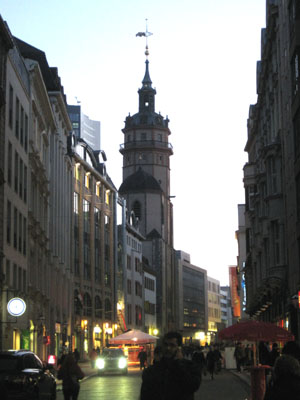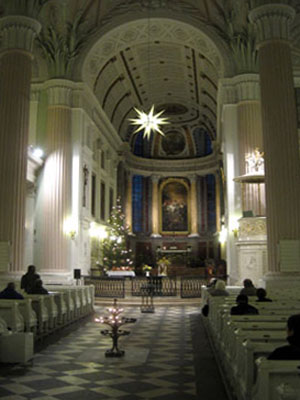| |
 |
 |
 |
| Comment on this report, or find other reports. |
 |
| Our Mystery Worshippers are volunteers who warm church pews for us around the world. If you'd like to become a Mystery Worshipper, start here. |
 |
| Find out how to reproduce this report in your church magazine or website. |
|
|
| 2123: Nikolaikirche
(St Nicholas), Leipzig, Germany |
 |
 |
 |
Mystery Worshipper:
Portola.
The church:
Nikolaikirche (St Nicholas), Leipzig, Germany.
Denomination: The
Lutheran Church in Saxony.
The building:
This is the largest church in Leipzig, founded in about 1165,
situated at the intersection of two major trade routes. Dedicated
to Nicholas, the patron saint of merchants, it is located in
the heart of the city centre. Originally built in a Romanesque
style, in the early 16th century it was restructured into a
Gothic hall church. In Bach's day it was baroque. Rich classical
ornamental decoration was added to the ceiling, the galleries,
the pulpit and the pews in the 18th century. The balconies and
pews are white, which is the dominant colour. The columns resemble
palm trees, reminders of Christ's triumphant entry into Jerusalem
as Messiah. At the base of the columns are depictions of wreaths
(ancient symbols of victory), and the columns lead to the ceiling,
where a representation of paradise is displayed. The late Romanesque
wooden crucifix in the sanctuary is the oldest work of art in
Leipzig.
The church:
When Luther brought the Reformation to Leipzig in 1539, Nikolaikirche
immediately became a Lutheran church. JS Bach served regularly
here as well as at Thomaskirche. Nikolaikirche is also host
to the Christian community of the University of Leipzig, whose
church was senselessly demolished in 1968 by the communist regime.
But what really makes this church extraordinarily special were
the "prayers for peace" that helped initiate the peaceful revolution
that brought down the Iron Curtain. Since 1982 there had been
prayers for peace every Monday at 5.00pm. In 1988 these services
became a focal point for the dissent and frustration of those
suffering under the oppression of the East German regime. For
many people who had been raised as atheists, the prayer services
offered their first direct and lively encounter with the Bible
and with prayer. In 1989 there was an escalation of tension.
The police, in a futile attempt to stem the tide, arrested or
detained participants in the prayer-for-peace services. On 9
October 1989, 70,000 people from around the country gathered
in Leipzig for prayer. Nikolaikirche was filled to overflowing
and other inner-city churches opened their doors as well. At
the end of the prayer-for-peace services, people leaving the
churches were welcomed by 10,000 waiting outside with candles
in their hands. Jesus' spirit of non-violence seized the masses.
Troops, militia and the police were drawn in, became engaged
in conversations, and withdrew. A high government official stated:
"We were prepared for everything except for candles and prayers."
This evening turned out to be a decisive turning point. Eleven
days later the head of government, Erich Honecker, was forced
to resign. On 9 November the border to the West was opened.
A year later Germany was reunited. The Monday prayer services
at 5.00pm continue to this day, focusing on new themes, such
as unemployment.
The neighbourhood:
Nikolaikirche is in the heart of the inner city in a pedestrian
zone. It is a five-minute walk to the main train station, a
ten-minute walk to the renowned Thomaskirche (St Thomas), and
a five-minute walk to the place where the university church
stood and where a new complex is being built that will contain
a new chapel.
The cast:
This service was the start of an International Week of Prayer
2011, involving various denominations meeting daily in prayer
at different churches and centres. The Revd Bernhard Stief of
St Nicholas greeted the congregation, led prayer, and gave the
blessing. The Revd Martin Reakes-Williams, an Anglican chaplain
serving at the English church in Leipzig, led the service and
filled in as preacher, as the scheduled preacher could not participate
due to illness. There were other participants and a keyboard
player but they were not introduced or listed.
The date & time: Monday,
10 January 2011, 5.00pm.
What was the name of the service?
Prayer for Peace.
How full was the building?
About 50, in a church that can hold 2,000.
Did anyone welcome you personally?
Someone was handing out hymn books but did not really greet
visitors.
Was your pew comfortable?
Yes. The white pews also looked inviting and cheerful.
How would you describe the pre-service
atmosphere?
There was some sporadic and lively conversation going on, as some of the participants seemed to know one another well. Otherwise, the conversations were subdued.
What were the exact opening words of the
service?
"The peace of the Lord be with all."
What books did the congregation use during the
service?
Singt von Hoffnung: Neue Lieder für die Gemeinde (Sing
of Hope: New Songs for the Congregation).
What musical instruments were played?
Electric keyboard.
Did anything distract
you?
It was not easy to find a distraction because the congregation
participated with concentration and discipline. The only distraction
came from my own thoughts: trying to visualise the situation
in this church on 9 October 1989, filled with over 2,000 people
tense with anxiety as to what would happen on the streets of
Leipzig, wondering whether they would be arrested or battered
senseless after the service. This is the reason I was here:
to imagine the prayer services of 1989.

Was the worship stiff-upper-lip,
happy clappy, or what?
The prayer for peace apparently does not have a set order of service or a certain style. Every week there is a different person or group responsible for structuring the service. There was a variety of prayers: an introductory prayer, prayers for personal situations, prayers for Christian initiatives (preceded by descriptions of the challenges facing these initiatives), prayers for the city government (including prayer for an initiative to establish a Christian chapel in the city hall), prayers for Christians in the world, especially for persecuted Christians, prayers for hot spots (Iraq, Sudan, Yemen). There was also time for quiet prayer. And at one point we were invited to create small prayer groups and pray spontaneously for Christians in the world. The service had a clear structure that was carried out with concentration and care. We sang contemporary Christian songs, which the congregation seemed to enjoy singing, but there was no question of getting carried away with enthusiasm. This service was characterised by an atmosphere of naturalness: no pretension, no forced cheerfulness, no moralising, no exaggeration.
Exactly how long was the sermon?
11 minutes.
On a scale of 1-10, how good was the preacher?
7 – The preacher from England spoke clear and correct German.
I enjoyed listening to him because he spoke in a natural, unassuming
manner. The tone of his sermon matched the tone of the service.
He spoke in a down-to-earth way and made some striking comments
and creative comparisons that kept my attention.
In a nutshell, what was the sermon
about?
The sermon was based on Philippians 2:1-11 (imitating Christ's
humility), which contains a hymn praising Jesus, who relinquished
his divinity to assume the human condition, to become like a
slave, to die on the cross for our sake. Those who belong to
Christ are called to do likewise, relinquishing self-interest
and self-importance to pursue that which fellow humans need.
People, even Christians and even ministers, tend to build up
self-esteem by comparing themselves with others and thus secretly
enjoying the failures of others. But we are called to unconditional
love, as exemplified in Jesus, which consists of respect and
humility. The text from Philippians celebrates the day on which
Christ will be universally recognised and worshipped as Lord.
May what we do contribute to bringing about this day of consummation.
Which part of the service was like being in
heaven?
Being in this beautiful church for an evening service, seeing its striking ornamentation and thinking about its place in history was a piece of heaven.
And which part was like being in... er... the other place?
At one point we were invited to form small prayer groups and
pray for Christians world-wide. At this moment I felt somewhat
lost. The people in front of us knew one another and formed
a group. The people behind us knew one another and formed another
group. Mrs Portola and I seemed to be in no-man's land. Then
the group behind us invited us to join them. Two or three people
in the group prayed several times, but although I could identify
with their prayers I found it difficult to find my role. It
was strange to be a part of a group of earnestly praying Christians,
but at the same time feeling cut off from this fellowship. This
must be what the "other place" feels like.
What happened when you hung around after the service looking lost?
Standing around looking lost did not attract anyone's attention,
because this was not a regular congregation, but a collection
of individuals who were sitting quietly or talking in small
groups in various parts of the church or heading toward a side
room for tea and coffee.
How would you describe the after-service
coffee?
The after-service coffee looked inviting. It was in a cosy side
room of the church. Aside from coffee there were a variety of
teas available. Also offered were belegte Brötchen (open-faced
sandwiches on bread rolls). I am sure that if I had stayed I
would have become engaged in interesting conversation, but I
was tired and wanted to get home.
How would you feel about making this church your regular (where 10 = ecstatic, 0 = terminal)?
8 – This church and this congregation are full of vitality.
They offer many activities and groups and have a unique heritage.
It would be a privilege to be a part of this Christian community.
But I would need to know more about what happens on Sunday and
during the week before really deciding if I could find my place
and my identity in this community.
Did the service make you feel glad to be a
Christian?
The tone of the service – warm-hearted and unpretentious
– made me glad to be a Christian. This service demonstrated
the concern of Christianity for all that is going on in the
world, especially as it affects those who are helpless. This
service, which contained so many different types of prayer,
conveyed the message that God can be trusted and that all glory
belongs to him.
What one thing will you remember about all this in seven days' time?
The image that remains with me are the palm-tree-like columns. |
|
|
 |
 |
 |
| We rely on voluntary donations to stay online. If you're a regular visitor to Ship of Fools, please consider supporting us. |
 |
 |
 |
| The Mystery Pilgrim |
 |
| One of our most seasoned reporters makes the Camino pilgrimage to Santiago de Compostela in Spain. Read here. |
 |
 |
 |
| London churches |
 |
| Read reports from 70 London churches, visited by a small army of Mystery Worshippers on one single Sunday. Read here. |
| |
|
|
|
|


